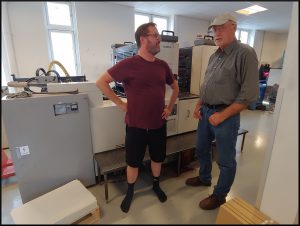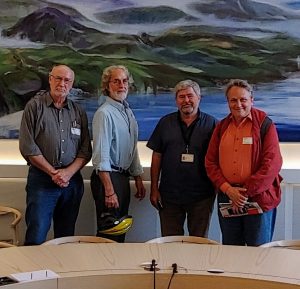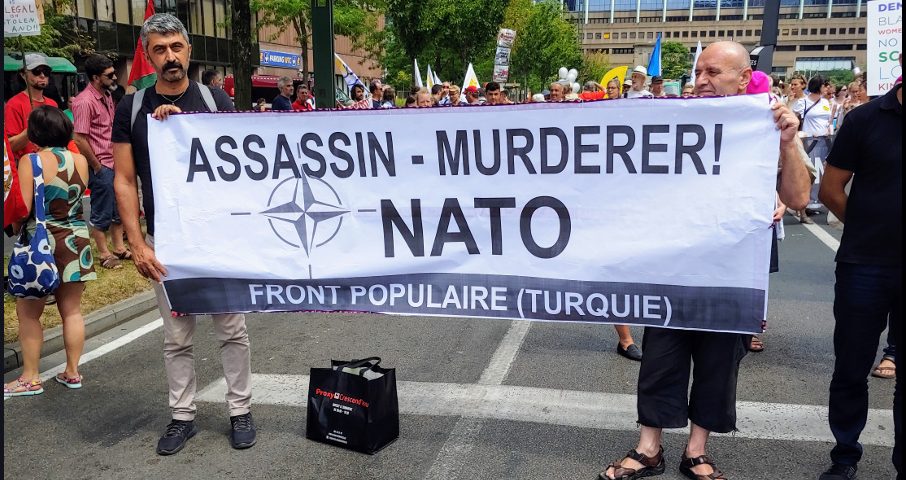by Phil Wilayto, Friday, July 6, 2018
See “My Peace Travels Around Europe” Part 1: On the Road for Peace, Part 2: Civil Resistance at Ramstein, Part 4: No to NATO; Yes to NHS
Tonight Belgium beat Brazil in the World Cup soccer semi-finals, and the streets of Brussels, the capital city, are exploding with people celebrating. Really exploding. I don’t think I’m going to get much sleep.
Belgium is one of the most impressive cities I’ve ever seen. The city center is dominated by enormous public squares surrounded by massive rows of buildings with intricately carved facades that make the whole place look like some kind of European fairyland.
And on nearly every block there’s at least one shop selling the famous Belgium chocolates, considered by chocoholics to be the best in the world. Belgium took on its role in chocolate making after King Leopold II took over the Congo in 1885 and ran it as his private plantation, importing rubber, ivory and cocoa. The exploitation and inhuman cruelty was so intense that some 10 million Congolese died. It was truly genocide, and the phenomenal profits enabled Belgium to develop as a leading European power. If you have a strong stomach, check out this little essay: Severed Hands in Antwerp (Ed: the photos of Antwep are beautiful as the story is ugly)
I’m in town to speak at two conferences taking place here this weekend in connection with the annual NATO Summit meeting, scheduled for July 11 and 12. The first conference, called by the World Peace Council, is tomorrow, with the second, by the No to NATO Coalition, on Sunday. And tomorrow afternoon there will be a big march that all the peace groups will join.
I’ll write more about NATO later, but for now it’s enough to say that the North Atlantic Treaty Organization was founded in 1949, with 12 members: the U.S. and Canada and 10 Western European countries. By then the wartime cooperation with the Soviet Union was long over and NATO was essentially an anti-Soviet military and political alliance.
Today the Soviet Union has been gone for 27 years, but NATO continues to grow.
Today the Soviet Union has been gone for 27 years, but NATO continues to grow. It now has 29 member countries, nearly half of which are either former members of the Soviet bloc or part of the former socialist state of Yugoslavia. All new members admitted into NATO since the collapse of the Soviet Union are in Central or Eastern Europe. From a North American and Western European alliance, it has become a North American and all-European force that has moved steadily eastward, right up to Russia’s borders.
In NATO, the United States, United Kingdom and France together possess a total of 7,315 nuclear weapons. Russia is believed to have a total of 7,000. But in terms of overall military power, Russia’s military budget in 2016 was just over 8 percent of the combined total of all NATO countries, and just over 11 percent of the U.S. alone. This is important, because one of NATO’s founding principles is that an attack on any one member country is to be considered an attack on all NATO members.
Today Russia is faced with a massive military and political alliance that includes Estonia and Latvia, two of the five countries on its Western and Southern borders. Georgia, which borders Russia’s southern flank, is not yet a NATO member, but has been accepted for membership, pending meeting certain internal “reform” requirements. And Ukraine, with its 1,200-mile land border with Russia, is being groomed to join NATO,
And yet we are told that it’s Russia that is threatening the West.
After leaving Germany, where I took part in the antiwar protests at the U.S. Ramstein Air Force Base, I took a train to Vienna, Austria, to meet with a political group that had organized an event on May 2 in solidarity with the anti-fascist movement in Odessa, Ukraine. I coordinate the Odessa Solidarity Campaign of the United National Antiwar Coalition, so I wanted to take the opportunity to get to know this group. Meeting in a Vienna café, we learned we had a great deal in common and agreed to work together on Odessa solidarity in the coming year.
Back on May 2, 2014, a fascist mob murdered at least 42 people in Odessa who were opposed to the right-wing February coup promoted by the U.S. government. Although there was extensive video coverage of the attack (just Google “Odessa May 2, 2014”), to date not one of the murderers has been brought to justice. Ever since, the families of those who were killed have been demanding an international investigation into the massacre, and each May 2 solidarity groups around the word hold local actions to support that demand.
The Viennese comrades also told me that on Saturday, while I was getting arrested in Germany, 100,000 union members had rallied in Vienna to oppose a new law that would allow employers to force their workers to work up to 12 hours a day. The standard now is 8 hours, so this is a huge change. The Austrian workers are understandably outraged and hopefully will be able to overturn the new law.
I wanted to to see how the working-class movement here is dealing with repression by the new right-wing governments
This is another reason for my trip to Europe: to see how the working-class movement here is dealing with repression by the new right-wing governments. What’s happening now in the U.S. with President Rump has already been happening in Poland, Hungary, Ukraine, Austria and now Italy. Right-wing parties are coming to power by pretending to care about working people while blaming all their countries’ problems on immigrants. I think that learning about what is happening now in Europe can can help us better prepare for our own struggles at home.
 After Vienna, it was a short flight to Copenhagen, the capital of Denmark, where I met with a Swedish activist named Tord Bjork, who’s with a group called Activists for Peace, which had helped organize local events on May 2 around Europe. Between those events and the ones the OSC organized in the U.S., there were at least 40 actions. We were able to have some really good conversations about how to coordinate in the future, and I have high hopes that on May 2, 2019, there will be many more local solidarity actions, not only in Europe and the U.S, but in Asia, Africa and Latin America as well.
After Vienna, it was a short flight to Copenhagen, the capital of Denmark, where I met with a Swedish activist named Tord Bjork, who’s with a group called Activists for Peace, which had helped organize local events on May 2 around Europe. Between those events and the ones the OSC organized in the U.S., there were at least 40 actions. We were able to have some really good conversations about how to coordinate in the future, and I have high hopes that on May 2, 2019, there will be many more local solidarity actions, not only in Europe and the U.S, but in Asia, Africa and Latin America as well.
Tord also set up an interview with The Daily Worker, the newspaper of the Danish Communist Party, about our Odessa work. Their daily circulation of 5,000 in a country of 5 million would be like having more than 300,000 in the U.S. (The Virginia Defender prints 15,000 copies, but we are far from a daily.)
 The next stop was a meeting that Tord set up with a member of the Danish Parliament, a leader in the Red-Green Alliance, a leftist party that has 14 seats in the 179-member parliament. We had a great discussion about how he might be able to help with the Odessa work, so all in all it was a really productive day.
The next stop was a meeting that Tord set up with a member of the Danish Parliament, a leader in the Red-Green Alliance, a leftist party that has 14 seats in the 179-member parliament. We had a great discussion about how he might be able to help with the Odessa work, so all in all it was a really productive day.
It’s almost midnight, so I should end here and get some rest before the first conference tomorrow.
I know these reports are long, but so little attention is paid to issues of war and peace in the U.S. that I want to at least try to share some information. If this is all I did, I suppose a lot of folks would just dismiss it as being irrelevant to their day-to-day lives. But with the Defenders’ work on Shockoe Bottom, the Confederate statues, supporting prisoners, the campaign to win justice for Marcus-David Peters, I’m hoping at least a few of you will take the time to check out this other work the Defenders do.
I really believe that any movement in the heart of the Empire that doesn’t take up the struggle against imperialist war will never be a truly revolutionary movement. It will be lost in reformism, fighting to make things a little better at home, while both the Democrats and Republicans wreck havoc on the rest of the world. Maybe someone will pay attention.
At least I can hope, right?
For a World of Justice & Peace for All,
Phil Wilayto
Editor, The Virginia Defender
Coordinator, Odessa Solidarity Campaign
Member, UNAC Administrative Committee

3 comments